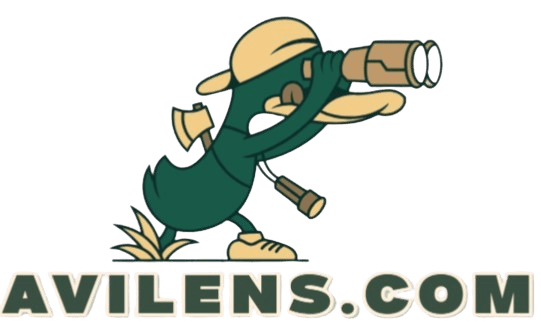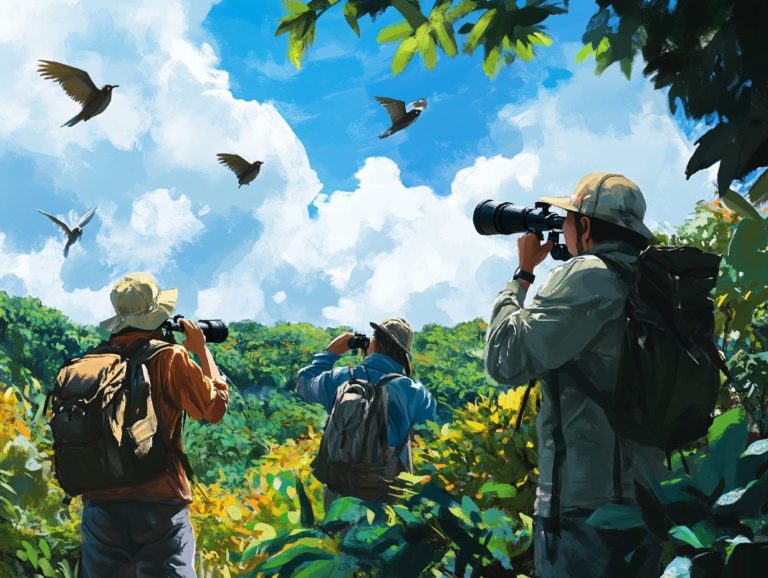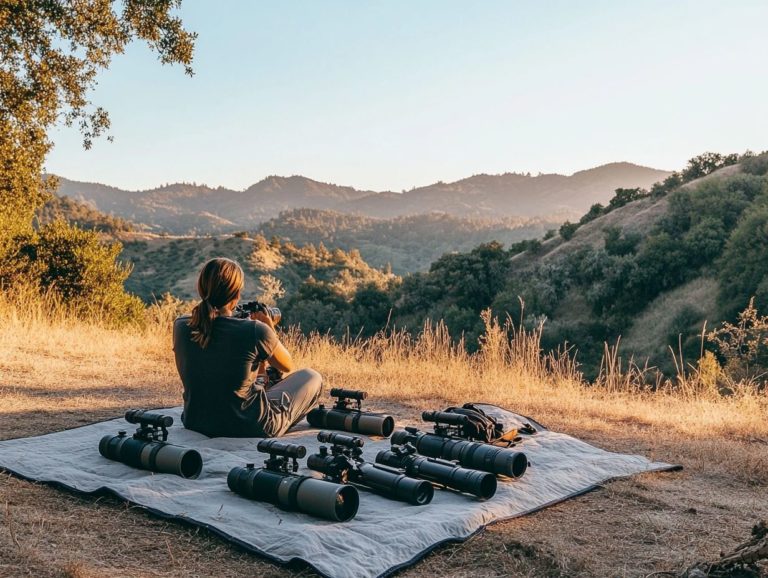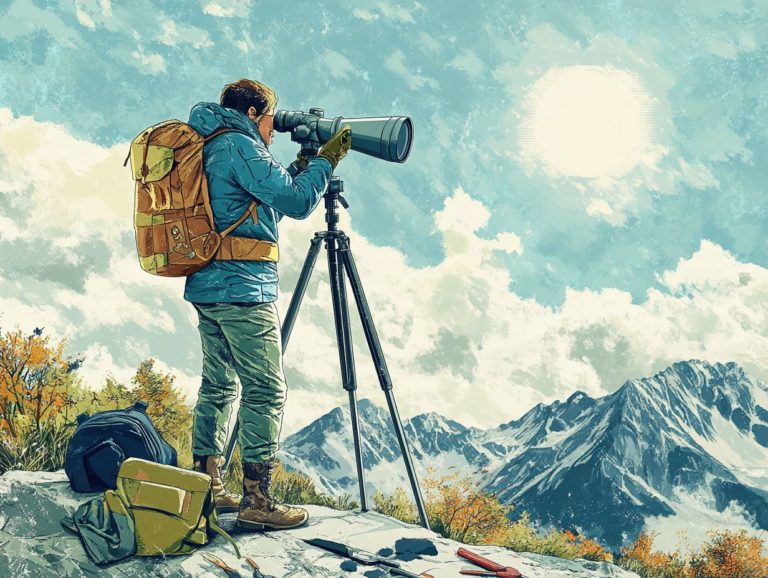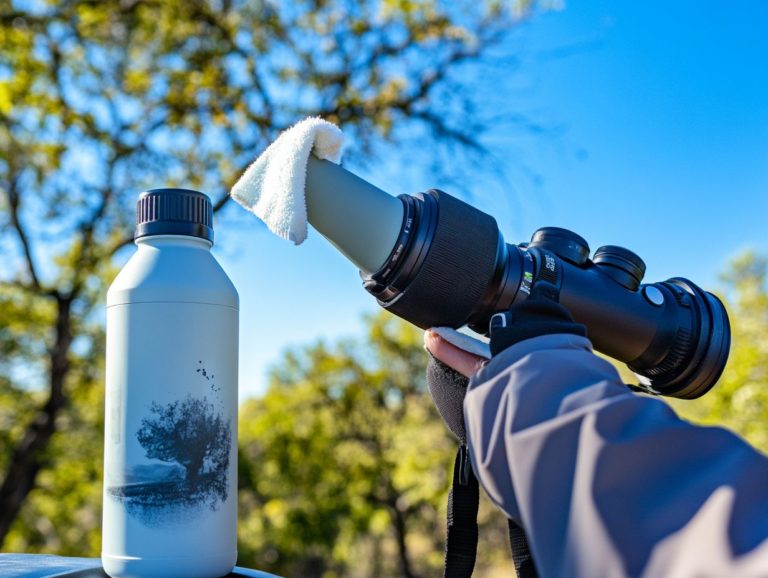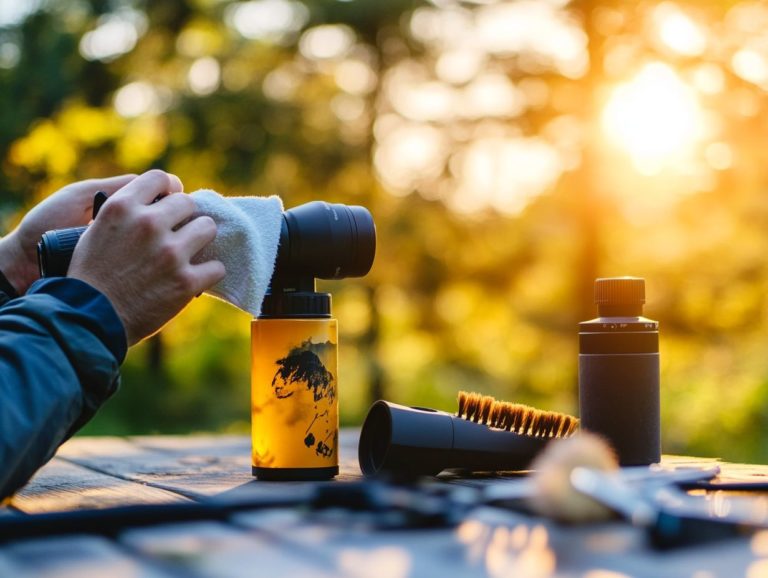How to Make the Most of Your Spotting Scope Setup
Choosing the right spotting scope can really change your outdoor adventures. Whether you re into bird watching, hunting, or exploring nature, a good scope makes a difference.
This guide covers the important factors to consider when selecting a spotting scope and offers effective setup techniques to ensure optimal performance.
Uncover valuable tips to enhance your viewing experience and maintenance advice to keep your equipment in prime condition. You ll also find a curated list of must-have accessories and common pitfalls to avoid.
Unlock the full potential of your spotting scope and see nature like you ve never seen before!
Contents
- Key Takeaways:
- Choosing the Right Spotting Scope
- Setting Up Your Spotting Scope
- Using Your Spotting Scope Effectively
- Maintaining Your Spotting Scope
- Accessories for Your Spotting Scope
- Common Mistakes to Avoid
- Frequently Asked Questions
- What is a spotting scope setup and why is it important?
- How do I choose the right spotting scope for my setup?
- What is the best way to set up a spotting scope for optimal viewing?
- How can I maintain my spotting scope setup for long-lasting use?
- What additional accessories can enhance my spotting scope setup, including binoculars and camera adapters?
- Can a spotting scope setup be used for other activities besides bird watching and wildlife observation?
Key Takeaways:
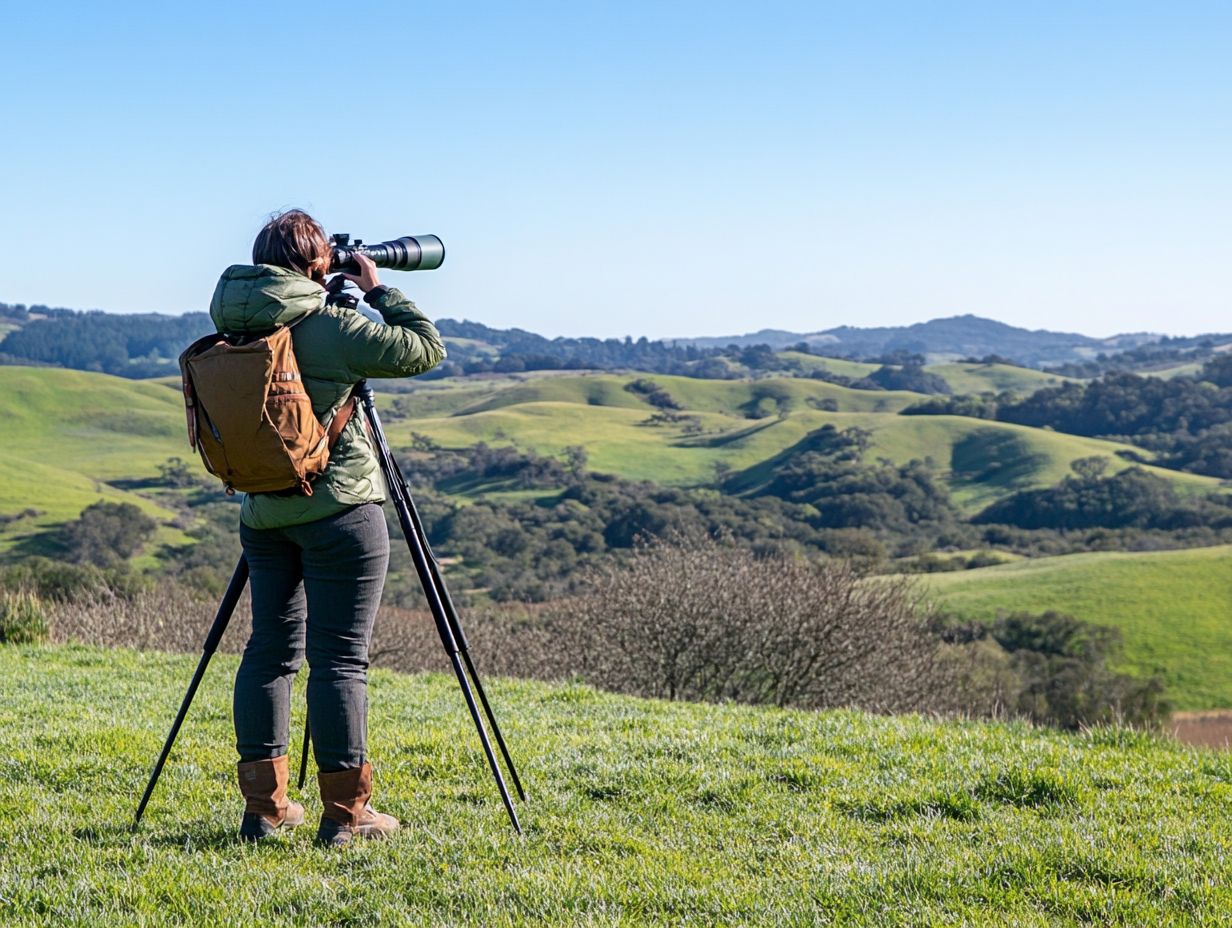
- Invest in a high-quality spotting scope that meets your specific needs and budget. Consider factors like high magnifications, size of the lens, and waterproof optics when making your decision.
- Set up your spotting scope properly by stabilizing the tripod, adjusting the height and angle, and using a remote shutter release for steady viewing.
- Enhance your experience by focusing on a specific area, using natural light, and adjusting the eyepiece for optimal viewing in varying viewing conditions.
Choosing the Right Spotting Scope
Selecting the perfect spotting scope is crucial for elevating your birdwatching and wildlife observation experiences. Regular spotting scope maintenance is especially important during activities like target shooting or hunting.
Opt for optics that deliver high magnification and exceptional image clarity. A thoughtfully chosen spotting scope allows you to immerse yourself in the beauty of nature with top-tier optics. It also provides important features to thrive in diverse outdoor conditions.
Factors to Consider
When selecting a spotting scope, consider several crucial factors like eye relief, waterproof optics, and tripod stability. These ensure you have a steady and enjoyable viewing experience.
Each of these elements plays a significant role in enhancing the overall effectiveness of your spotting scope. For example, having adequate eye relief is vital for comfort during extended use, allowing you to maintain a relaxed posture and preventing strain on your eyes.
Waterproof optics are essential for outdoor enthusiasts who face unpredictable weather. They guarantee functionality and reliability, enabling seamless observation even in rain or fog.
A sturdy tripod boosts stability and reduces the fatigue often associated with handheld observations. This makes it easier to track moving subjects and capture sharp, clear images.
Setting Up Your Spotting Scope
Setting up your spotting scope for optimal performance is essential for a rewarding wildlife watching and bird observation experience. A well-configured scope, detailed in our step-by-step guide, significantly enhances your viewing pleasure, making it easier to track moving subjects and savor the beauty of nature.
With the right setup, every moment spent in the field becomes more enriching and immersive.
Proper Setup Techniques
Proper setup techniques can greatly enhance your spotting scope’s functionality. This involves ensuring tripod stability, effectively utilizing adjustment features, and adapting zoom magnification for different viewing scenarios. For more detailed guidance, check out how to use spotting scopes for nature observation.
To start, achieving the optimal height is crucial. Adjust the tripod so that the eyepiece aligns perfectly with your eye level for a comfortable viewing experience. Stability is key; using a tripod with a wide footprint helps prevent vibrations, especially in windy conditions.
Selecting the appropriate zoom magnification level is crucial for different observations, whether you’re watching wildlife or enjoying long-distance views. If you’re interested in digiscoping, which means taking photos through your spotting scope using your smartphone, attaching an adapter opens up exciting possibilities for capturing stunning images.
With these tips, you re ready to dive into your outdoor adventures with confidence!
Using Your Spotting Scope Effectively
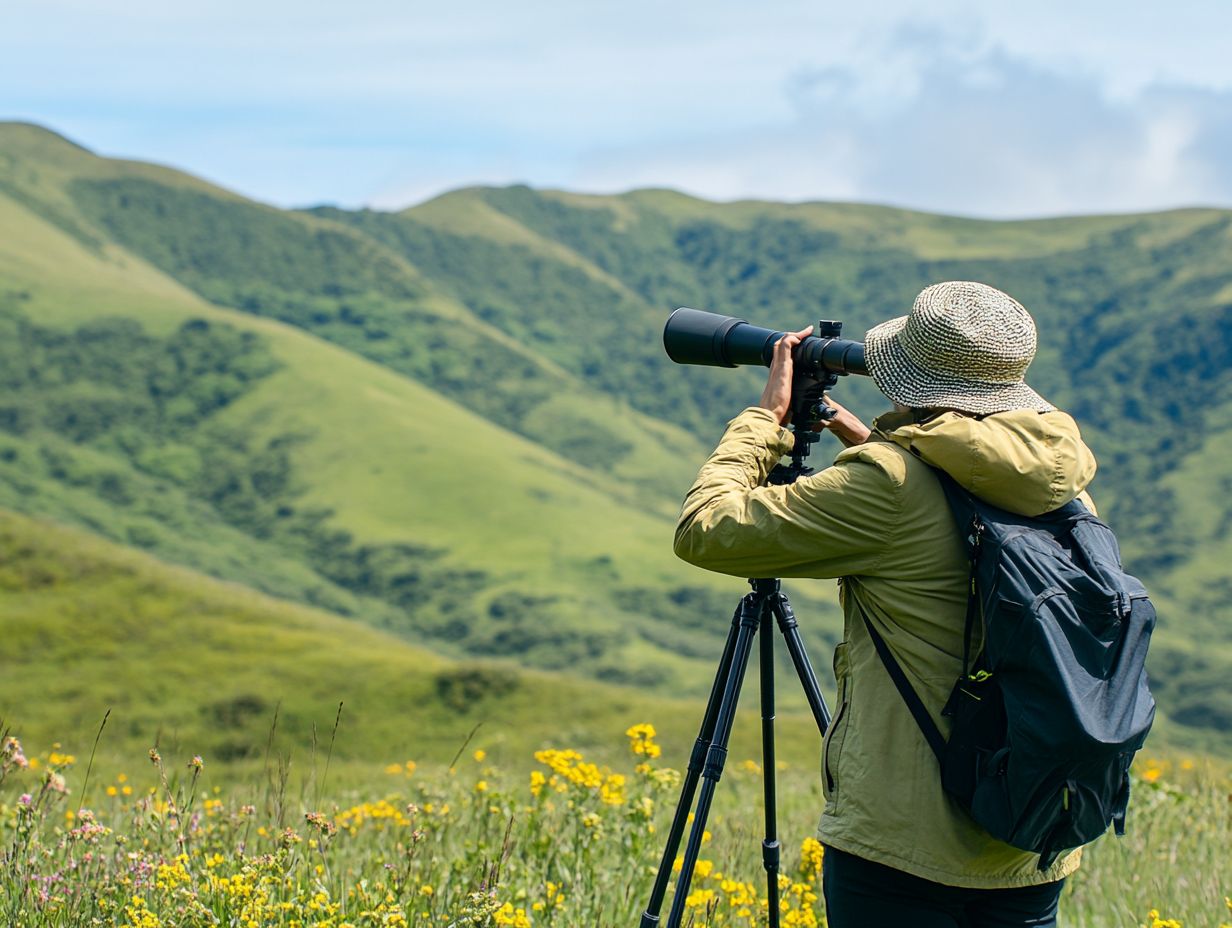
Using your spotting scope effectively can elevate your wildlife observation experiences. It offers breathtaking close-up views and remarkable image clarity, especially when enhanced with spotting scope accessories you shouldn’t miss, enabling precise identification of birds and other wildlife.
By choosing the right outdoor equipment, you can enhance this experience, transforming each outing into a truly memorable adventure.
Tips for Better Viewing
To truly enhance your viewing experience, pay attention to the weather conditions and light transmission. Making necessary adjustments can help you avoid eye strain while ensuring the best clarity.
For instance, on especially bright days, seek out shaded areas or adjust your screen brightness to improve visibility. Choosing screens with higher light transmission can significantly boost image quality, allowing for richer colors and sharper contrasts that really pop.
When watching for extended periods, remember to take short breaks. This simple habit can alleviate discomfort and combat fatigue. Use features like blue light filters to reduce eye strain, making it easier to stay engaged without sacrificing comfort.
By taking a balanced approach to these factors, you can create a more enjoyable and healthier viewing experience.
Maintaining Your Spotting Scope
Maintaining your spotting scope is vital for preserving its performance and longevity. By following effective cleaning and care tips, you can keep its durable design and high-quality optics in top shape for your outdoor adventures.
Cleaning and Care Tips
Cleaning and care tips are essential for keeping the optical performance of your spotting scope at its best. Regularly check the lens quality and always use a protective case to shield it from damage.
Using specific cleaning techniques will ensure the longevity of your equipment without compromising its integrity. To clean the lens effectively, use a microfiber cloth and a lens cleaning solution made for optical surfaces to minimize scratches. It’s also crucial to store your scope in a padded case when not in use, protecting it from dust and impacts.
Conduct routine maintenance checks for dirt buildup or seal deterioration. This proactive approach not only prolongs performance but also helps you avoid costly repairs. Follow these exciting care tips to keep your spotting scope in top shape!
Accessories for Your Spotting Scope
Accessories for your spotting scope can truly enhance your observation experience. Whether you prefer an angled model for comfortable viewing or a straight setup for quick adjustments, there are options available to suit your needs.
Consider adding a camera adapter for digiscoping using a camera with a spotting scope to take photos of distant subjects to capture stunning moments with precision and clarity.
Must-Have Additions
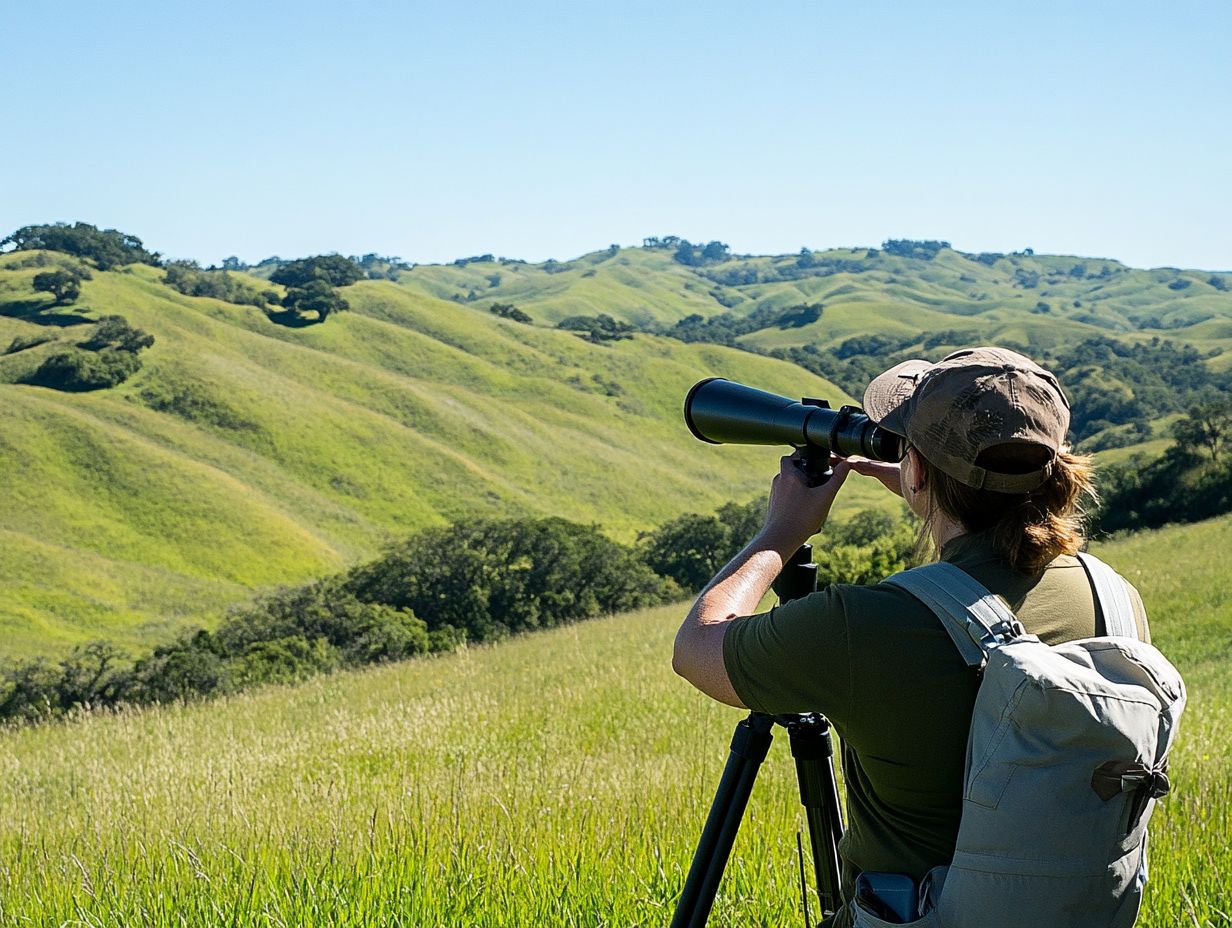
Must-have additions for your spotting scope include high-quality tripod heads like Arca Swiss or Gitzo heads, which enhance stability and versatility in your outdoor setups.
These tripod heads provide sturdy support and smooth panning adjustments for effortlessly tracking moving subjects. When paired with a durable tripod, they allow for precise positioning, whether you’re observing wildlife or stargazing.
Accessories such as quick-release plates can speed up your setup transitions, ensuring you capture every moment without a hitch.
By using a versatile tripod setup, you maximize the functionality of your spotting scope, making each observation session more enjoyable and productive. For more insights, check out these tips for beginners.
Common Mistakes to Avoid
Avoiding common mistakes with your spotting scope is crucial for getting the best view and enhancing your wildlife observation experiences. For those looking to improve their skills, learning how to use a spotting scope with a camera can make a significant difference.
Pay particular attention to proper scope setup and ensuring the stability of your tripod. For more insights, consider the top features to look for in a spotting scope; these details can make a significant difference in your viewing experience.
How to Prevent Errors
To avoid mistakes while using your spotting scope, it s essential to become familiar with the focus knob and other adjustment features. This familiarity helps you adapt to varying outdoor conditions, ensuring you achieve optimal image clarity.
Practice regularly to enhance your skills. Begin by experimenting in diverse environments, such as open fields, forests, or hillsides, where lighting and distances can vary widely.
Establishing a consistent routine is beneficial. This allows you to instinctively recall the proper settings for specific situations. For example, adjust the eyepiece position for your glasses or fine-tune the zoom for distant objects.
Regular practice not only sharpens your skills but also boosts your confidence in managing unexpected variables. This ultimately enriches your overall viewing experience with your spotting scope.
Frequently Asked Questions
What is a spotting scope setup and why is it important?
A spotting scope setup refers to the combination of a spotting scope, which may include an angled model or a straight viewing option, and a tripod used for long-range viewing. A good setup keeps your view steady and clear, so you don’t miss a thing!
How do I choose the right spotting scope for my setup?
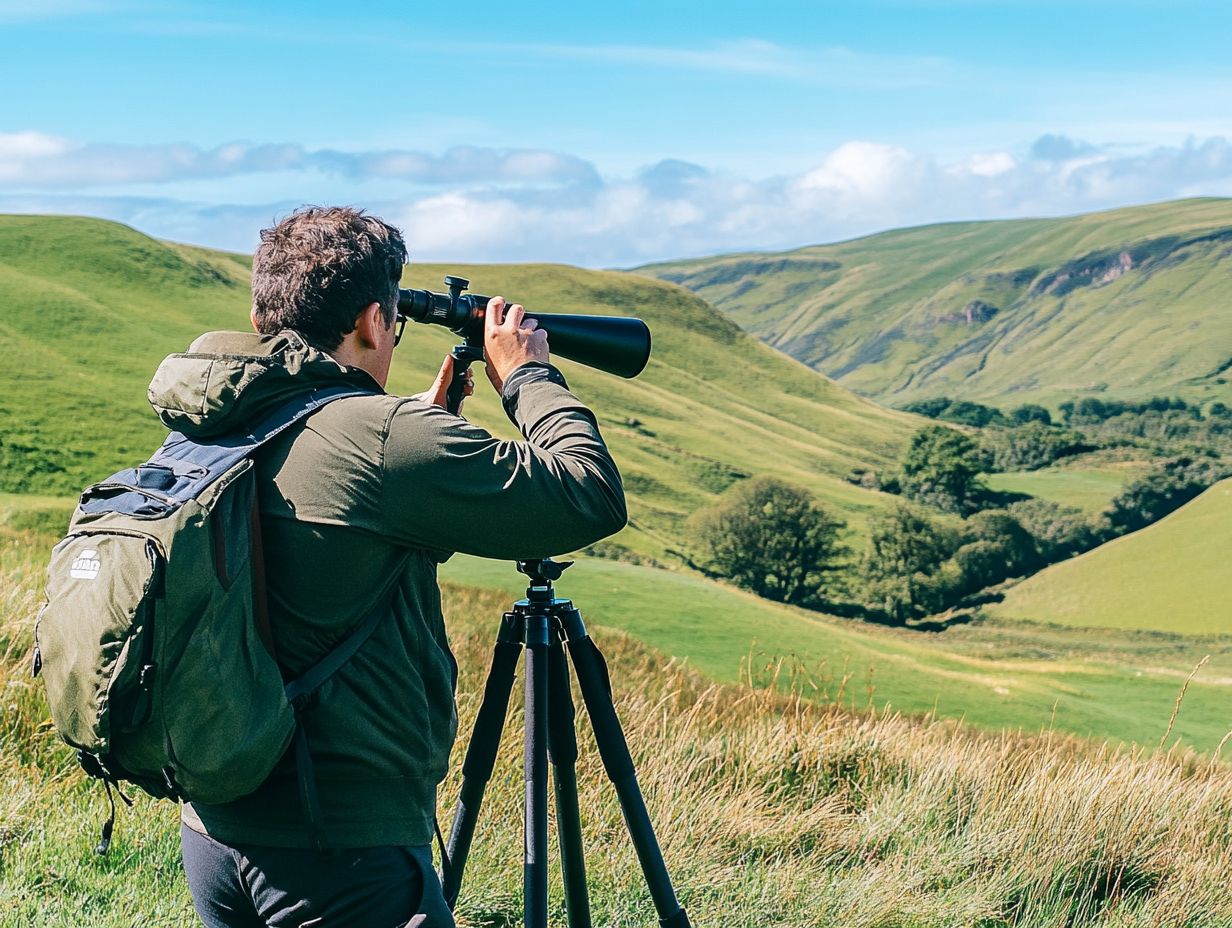
When choosing a spotting scope, consider factors such as magnification, objective lens size, lens quality, and price. It’s also important to choose a scope that is compatible with your tripod and accessories, ensuring tripod stability for optimal performance.
What is the best way to set up a spotting scope for optimal viewing?
First, make sure your tripod is stable and level. Then, attach the spotting scope securely to the tripod and adjust the height and angle to your desired viewing position. For those interested in enhancing their birdwatching experience, you can learn how to use a smartphone with your spotting scope for better observation.
Finally, adjust the focus and zoom settings for the best image quality.
How can I maintain my spotting scope setup for long-lasting use?
Keep your spotting scope in top shape by regularly cleaning the lenses and ensuring the tripod is in good condition. To ensure its longevity, learn how to store your spotting scope safely, avoiding exposure to extreme temperatures or harsh elements, and always store it in a protective case when not in use.
What additional accessories can enhance my spotting scope setup, including binoculars and camera adapters?
There are many accessories that can enhance your spotting scope setup, such as a digiscoping adapter for taking photos, a sunshade for reducing glare, and a carrying case for easy transportation. Additionally, consider using hunting optics and waterproof optics for diverse outdoor conditions.
It’s also helpful to have a stable and comfortable spotting scope chair for extended viewing sessions.
Can a spotting scope setup be used for other activities besides bird watching and wildlife observation?
Yes, a spotting scope setup can be used for various outdoor activities, such as hunting, wildlife observation, and even stargazing. It is a versatile tool that allows for clear and detailed viewing of distant objects in any outdoor setting.
Grab your spotting scope and explore the great outdoors today!
